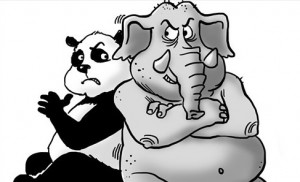Braha Chellaney writes: In recent years, the People’s Liberation Army has been taking advantage of its rising political clout to provoke localized skirmishes and standoffs with India by breaching the two countries’ long and disputed Himalayan frontier. The PLA’s recent intensification of such border violations holds important implications for President Xi Jinping’s upcoming visit to India – and for the future of the bilateral relationship.
In fact, such provocations have often preceded visits to India by Chinese leaders. Indeed, it was just before President Hu Jintao’s 2006 visit that China resurrected its claim to India’s large northeastern state of Arunachal Pradesh.
By contrast, Indian prime ministers since Jawaharlal Nehru have traveled to China to express goodwill and deliver strategic gifts. Unsurprisingly, India has often ended up losing out in bilateral deals.
China’s annexation of Tibet, without securing (or even seeking) recognition of the then-existing Indo-Tibetan border. In fact, under the treaty, India forfeited all of the extraterritorial rights and privileges in Tibet that it had inherited from imperial Britain.
As agreed in the pact, India withdrew its “military escorts” from Tibet, and conceded to the Chinese government, at a “reasonable” price, the postal, telegraph, and public telephone services operated by the Indian government in the “Tibet region of China.” For its part, China repeatedly violated the eight-year pact, ultimately mounting the trans-Himalayan invasion of 1962.
In short, China used the Panchsheel Treaty to outwit and humiliate India. Yet, just this summer, Prime Minister Narendra Modi’s new government sent Vice President Hamid Ansari to Beijing to participate in the treaty’s 60th anniversary celebrations.
Ansari was accompanied by Commerce Minister Nirmala Sitharaman, who, during her stay, signed an agreement allowing China – without any quid pro quo – to establish industrial parks in India. This will exacerbate existing imbalances in the bilateral trade relationship – China currently exports to India three times more than it imports from the country, with most of these imports being raw materials –thereby exposing India to increased strategic pressure and serving China’s interest in preventing India’s rise as a peer competitor.
A reminder of that came at July’s BRICS summit of Brazil, Russia, India, China, and South Africa, when, yet again, China emerged ahead of India. The BRICS’ New Development Bank, it was announced, will be headquartered in Shanghai, not New Delhi; India’s consolation prize was that an Indian will serve as the Bank’s first president.
India must consider carefully the pretense of partnership with China that it is forming through trade and BRICS agreements – at least until a more balanced bilateral relationship emerges. After all, neither booming trade nor membership in the BRICS club offers protection from bullying.

